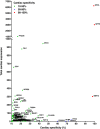A combined bioinformatics, experimental and clinical approach to identify novel cardiac-specific heart failure biomarkers: is Dickkopf-3 (DKK3) a possible candidate?
- PMID: 32809235
- PMCID: PMC7756877
- DOI: 10.1002/ejhf.1988
A combined bioinformatics, experimental and clinical approach to identify novel cardiac-specific heart failure biomarkers: is Dickkopf-3 (DKK3) a possible candidate?
Abstract
Aims: Cardiac specificity provides an advantage in correlating heart failure (HF) biomarker plasma levels with indices of cardiac function and remodelling, as shown for natriuretic peptides. Using bioinformatics, we explored the cardiac specificity of secreted proteins and investigated in more detail the relationship of Dickkopf-3 (DKK3) gene expression and DKK3 plasma concentrations with cardiac function and remodelling in (pre)clinical studies.
Methods and results: The cardiac specificity of secreted proteins was determined using RNAseq data for a large panel of organs and tissues. This showed that natriuretic peptides (NPPA and NPPB) are highly cardiac-specific (>99%), whereas other HF biomarkers, including galectin-3 (Gal-3, LGALS3) and growth differentiation factor-15 (GDF-15), lack cardiac specificity (<4%). DKK3 was cardiac-enriched (44%), warranting further investigation. In three different HF mouse models, cardiac Dkk3 expression was altered, but DKK3 plasma concentrations were not. In humans, DKK3 plasma concentrations were higher in HF patients (n = 2090) in comparison with age- and sex-matched controls without HF (n = 240) (46.4 ng/mL vs. 36.3 ng/mL; P < 0.001). Multivariate regression analysis revealed that DKK3 was strongly associated with HF risk factors and comorbidities, including age, kidney function and atrial fibrillation. After correction for existing prediction models, DKK3 did not independently predict HF outcome [all-cause mortality/HF hospitalization, hazard ratio 1.13 (0.79-1.61) per DKK3 doubling; P = 0.503].
Conclusions: Of actively secreted HF biomarkers, only natriuretic peptides showed high cardiac specificity. Despite a cardiac specificity of 44%, secreted DKK3 had limited additional diagnostic and prognostic value.
Keywords: Biomarker; Cardiac specificity; DKK3; Heart failure; Natriuretic peptides.
© 2020 The Authors. European Journal of Heart Failure published by John Wiley & Sons Ltd on behalf of European Society of Cardiology.
Figures



Comment in
-
Beating the bushes for biomarkers.Eur J Heart Fail. 2020 Nov;22(11):2075-2077. doi: 10.1002/ejhf.2004. Epub 2020 Oct 5. Eur J Heart Fail. 2020. PMID: 32945573 No abstract available.
References
-
- Yancy CW, Jessup M, Bozkurt B, Butler J, Casey DE Jr, Colvin MM, Drazner MH, Filippatos GS, Fonarow GC, Givertz MM, Hollenberg SM, Lindenfeld J, Masoudi FA, McBride PE, Peterson PN, Stevenson LW, Westlake C. 2017 ACC/AHA/HFSA focused update of the 2013 ACCF/AHA Guideline for the Management of Heart Failure: a report of the American College of Cardiology/American Heart Association Task Force on Clinical Practice Guidelines and the Heart Failure Society of America. J Card Fail 2017;23:628–651. - PubMed
-
- Ponikowski P, Voors AA, Anker SD, Bueno H, Cleland JG, Coats AJ, Falk V, Gonzalez‐Juanatey JR, Harjola VP, Jankowska EA, Jessup M, Linde C, Nihoyannopoulos P, Parissis JT, Pieske B, Riley JP, Rosano GM, Ruilope LM, Ruschitzka F, Rutten FH, van der Meer P; Authors/Task Force Members . 2016 ESC guidelines for the diagnosis and treatment of acute and chronic heart failure: the Task Force for the diagnosis and treatment of acute and chronic heart failure of the European Society of Cardiology (ESC). Developed with the special contribution of the Heart Failure Association (HFA) of the ESC. Eur J Heart Fail 2016;18:891–975. - PubMed
-
- Levin ER, Gardner DG, Samson WK. Natriuretic peptides. N Engl J Med 1998;339:321–328. - PubMed
-
- Piek A, Du W, de Boer RA, Sillje HHW. Novel heart failure biomarkers: why do we fail to exploit their potential? Crit Rev Clin Lab Sci 2018;55:246–263. - PubMed
-
- Kinnunen P, Vuolteenaho O, Ruskoaho H. Mechanisms of atrial and brain natriuretic peptide release from rat ventricular myocardium: effect of stretching. Endocrinology 1993;132:1961–1970. - PubMed
Publication types
MeSH terms
Substances
Grants and funding
LinkOut - more resources
Full Text Sources
Medical
Research Materials
Miscellaneous

